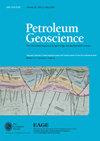The evolution of the Dowsing Graben System: implications for petroleum prospectivity in the UK Southern North Sea
IF 2.1
4区 地球科学
Q3 GEOSCIENCES, MULTIDISCIPLINARY
引用次数: 7
Abstract
Upper Permian (Zechstein Supergroup) evaporites have a major control on structural styles and prospectivity in the UK Southern North Sea (SNS). They form the regional super-seal for the main Rotliegend Group (Leman Sandstone Formation) reservoir play fairway immediately beneath. The evaporites have highly variable thicknesses due to the syndepositional basin architecture, differential loading and post-depositional deformation through diapirism and salt withdrawal. The halokinetic activity leads to touchdown (welding) of the supra-salt section onto the sub-salt strata and the development of narrow (up to 15 km-wide) graben systems. The interpretation and depth conversion of well-calibrated, high-quality, 3D post-stack time-migrated (PSTM) seismic data along the southwestern margin of the basin show that a NW–SE-striking elongate extensional Dowsing Graben System transects the area. The graben is defined by a series of large, overlapping, en echelon listric growth faults, with oblique secondary planar faults, which sole-out on two main (deep and shallow) décollement levels in the Zechstein Supergroup and the Middle Triassic Röt Halite Member. Whilst its initial formation was related to Mesozoic extension, the graben system also displays a contractional overprint resulting from regional compression and structural inversion during the Cenozoic. Detailed mapping of the Zechstein Supergroup has revealed that the evolution of the extensional system was influenced by the ESE–WNW-striking anhydrite–carbonate Zechstein shelf-margin. The occurrence of variable-thickness, low-velocity sediments within the graben impacts seismic imaging and depth conversion, leading to prospective structures being overlooked; something that has implications for prospectivity in the SNS and other evaporite basins where similar graben occur.道辛地堑系统的演化:对英国北海南部油气远景的启示
上二叠统(Zechstein超群)蒸发岩对英国南北海(SNS)的构造样式和远景具有重要控制作用。它们形成了紧邻下方的主要Rotliegend组(Leman砂岩组)储层通道的区域超级密封。同沉积盆地的构造、不同的负荷以及底辟作用和盐回作用导致的沉积后变形,使蒸发岩的厚度变化很大。盐动力学活动导致盐上部分与盐下地层接触(焊接),形成狭窄(宽达15公里)的地堑体系。对盆地西南缘标定良好、高质量的三维叠后时间偏移(PSTM)地震资料的解释和深度转换表明,该地区为北西-东向拉长伸展型地堑系横贯。该地堑由一系列大型的、重叠的、呈梯级状的表状生长断裂和斜向的次级平面断裂所确定,这些断裂在Zechstein超群和中三叠统Röt盐岩段的两个主要(深和浅)槽段上出斜。它的形成与中生代伸展作用有关,但在新生代由于区域挤压和构造反转的作用,也表现出收缩叠印的特征。通过对Zechstein超群的详细填图,揭示了Zechstein陆架边缘受东西西向硬石膏-碳酸盐岩影响的伸展体系演化。地堑内变厚度、低速沉积的赋存影响了地震成像和深度转换,导致有远景的构造被忽略;这对SNS和其他类似地堑发生的蒸发岩盆地的勘探前景具有重要意义。
本文章由计算机程序翻译,如有差异,请以英文原文为准。
求助全文
约1分钟内获得全文
求助全文
来源期刊

Petroleum Geoscience
地学-地球科学综合
CiteScore
4.80
自引率
11.80%
发文量
28
审稿时长
>12 weeks
期刊介绍:
Petroleum Geoscience is the international journal of geoenergy and applied earth science, and is co-owned by the Geological Society of London and the European Association of Geoscientists and Engineers (EAGE).
Petroleum Geoscience transcends disciplinary boundaries and publishes a balanced mix of articles covering exploration, exploitation, appraisal, development and enhancement of sub-surface hydrocarbon resources and carbon repositories. The integration of disciplines in an applied context, whether for fluid production, carbon storage or related geoenergy applications, is a particular strength of the journal. Articles on enhancing exploration efficiency, lowering technological and environmental risk, and improving hydrocarbon recovery communicate the latest developments in sub-surface geoscience to a wide readership.
Petroleum Geoscience provides a multidisciplinary forum for those engaged in the science and technology of the rock-related sub-surface disciplines. The journal reaches some 8000 individual subscribers, and a further 1100 institutional subscriptions provide global access to readers including geologists, geophysicists, petroleum and reservoir engineers, petrophysicists and geochemists in both academia and industry. The journal aims to share knowledge of reservoir geoscience and to reflect the international nature of its development.
 求助内容:
求助内容: 应助结果提醒方式:
应助结果提醒方式:


